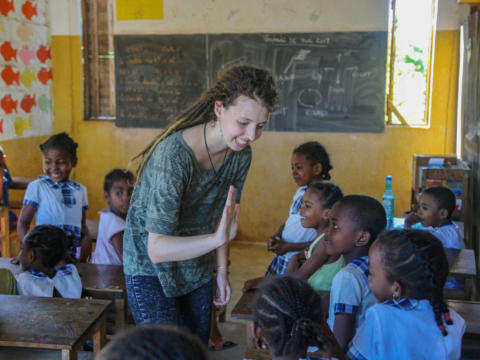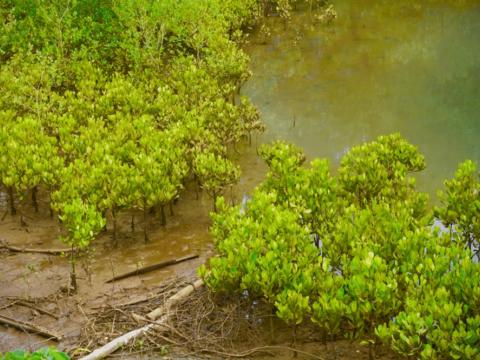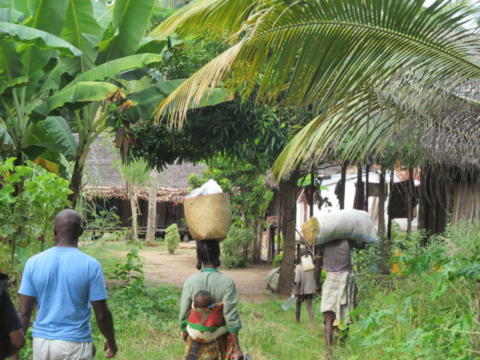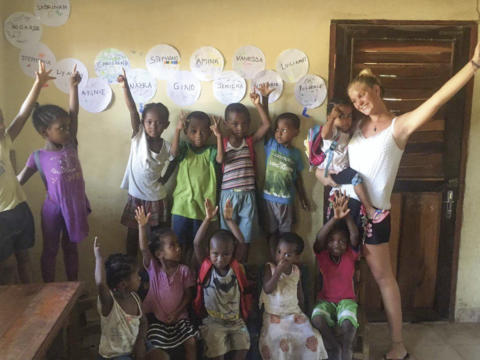Only 270€ per week!
Community Care
Nosy Be - Madagascar
Actively engage in the development of a local community by working to set up a showcase site. Also, contribute in bringing positive changes in the lives of women there, by sharing income-generating activities and working with them. You will also visit the surrounding villages and teach the Center’s cook and young trainees/staff about nutrition and the English language respectively.
Program Description
This program focuses on educating and empowering the underprivileged communities in Nosy Be, Madagascar. Our main task is to work with a community centre and support and conduct development and educational activities for the community.
We also support women with training and development for them to become independent entrepreneurs and empower them to initiate their own ways to earn a living.
Apart from training youth, the Center’s main goal is to set up a showcase site for surrounding villages and for all of Nosy Be. You will take part in setting up this showcase site and also teach the Center’s cook about nutrition.
You will also teach young trainees – as well as staff – English language, vis-a-vis the villagers. Participants will also teach them about nutrition and hygiene including the English language.
You will also get a good opportunity to contribute in bringing positive changes in the lives of women thereby sharing income-generating activities and working with them.
Aims & Objectives
To teach about nutrition and hygiene including English language. To enable the women by sharing with them income-generating activities.
Schedule
Monday
After breakfast, you will be meeting the ESPACE ZENY team and get to know about the history and taboos of the place. You will also visit the training centre and observe all the activities there. After a 20 minute break you will have a visit to the surrounding village and have discussions with the women there followed by lunch in the centre. Then you will move to ESPACE ZENY where you will teach English language to the trainees and staff there. After a 20 minute break, you will teach women about an income-generating activity and work with them.
Tuesday to Friday
You will set up a showcase site with the Center's team and trainees. Then you will teach nutrition and hygiene to Center's cook and cook with her. After lunch in the centre, you will move to ESPACE ZENY and teach English language to women and children in the surrounding village. Later you will teach them about nutrition and hygiene. You will also share ideas with women about income-generating activities and work with them.
Note: This schedule can be changed and/or amended depending on weather conditions, local conditions and unforeseen circumstances.
Participant Criteria & Requirements
Standard Requirements
Minimum age: –
Maximum age: –
Minimum English level: Basic
CRB required: On Signup
Passport copy required: On Signup
Resume copy required: No
Required qualification: None
Additional Requirements
Yellow fever vaccination is mandatory for all participants arriving in Madagascar.
Participants below 18 should have parental consent and participants above 65 should have medical clearance to take part in this program.
Additional Equipment
Dress Code
- Cover up as much as possible in the spirit of the local culture to avoid embarrassment.
- Your clothes must not be too short, too tight or too revealing. Kindly make sure your shoulders and legs are covered.
- It is completely fine to wear western clothes as long as they fit the local standards
- Be thoughtful of the graphics, symbols or text printed on your clothing and avoid wearing clothing styles that might be inappropriate
- Be thoughtful to poor communities by not displaying expensive items and clothes
- Wearing local clothes could help you build a good working relationship with the community
Location
Nosy is an island off the northwest coast of Madagascar. Nosy Be is Madagascar's largest and busiest tourist destination. It has an area of 320.02 square kilometers and its population was estimated at 73,010. Nosy Be means "big island" in the Malagasy language. The island was called Assada during the early colonial era of the 17th century.
Here you’ll find volcanic lakes, lemurs, rum distilleries, Ylang Ylang plantations and breathtaking coral reefs that are practically begging to be explored. In May, come to experience the four-day Donia Music Festival. Perfectly located on the Indian Ocean between Africa and Asia, Nosy-Be evokes feelings of discovery and adventure, the rich and endemic biodiversity will have begging for more. There are many spots that are perfect for ones who seek a golden opportunity to swim among turtles, stingrays or manta rays.
About the Accommodation
In our center, there is a dining room, a lounge area where you can hang out with fellow participants and a beautiful garden to relax. A balcony and large roof terrace is also available for you to spend some quality time.
Furthermore, there is a refrigerator which you are welcome to use to store food and beverages.
Food Arrangements
The meals are a mix of Western and Malagasy food, consisting mainly of vegetarian dishes including rice and vegetables. You can expect to have a chicken dish about twice a week. You can also use the kitchen facilities to cook for yourself or eat out at any of the local restaurants at your own expense.
Facilities
ATM – The closest ATM to the Center is about 15-20 minutes away by bus or Tuk-Tuk from the accommodation.
Supermarket – The closest local supermarket is around 15-20 minutes away by bus or Tuk-Tuk from the accommodation.
Activities & Events
No scheduled activities outside the program.
Sights & Surroundings
You can get sundrenched all year-round, and Nosy Be is a paradise for aqua activities. Nosy Be offers you a variety of activities which you can engage in your free time. The golden beaches are the highlights of Nosy be where you can swim, snorkel or even if you want to just sit back and enjoy the sunshine. Some of the beaches are namely,
- Palm Beach
- Andilana Beach
- Ambatoloaka Beach
- Andilana Beach
Nature enthusiasts and adventure lovers certainly find happiness around Nosy Be. Diurnal and nocturnal endemic lemur species, unique bird species, reptiles or indigenous plants and animals can be spotted among these breathtaking landscapes during your Nosy-Be weekend getaways.
Note: Please note that in Madagascar, the cyclone season is from January until April
Transportation
From this location we do not provide free transport to other locations.
Quick Facts
Name: Republic of Madagascar (Repoblikan’i Madagasikara)
Population: 25,054,000
Capital: Antànanarivo
Language: Malagasy (official) and 17 dialects apart from the official Malagasy language and French.
Currency: Ariary (Ar or MGA)
Time zone: UTC +3:00
Country Information
Because of its isolation from the major continents, Madagascar is considered as a jewel in biodiversity terms, an exotic country with a high concentration of endemic species. Madagascar’s flagship species are 100% endemic with 101 lemur species. Of 285 bird species recorded 105 are unique to the country. Three fourths of Madagascar’s 860 orchid species are endemic to the island and 6 of the world’s 8 baobab species are found nowhere else in the world. But, human presence constantly threatens these wonders. Over 90% of Madagascar’s wildlife is endemic and cannot be seen wild anywhere else on earth.
Madagascar’s cultural richness differs from one ethnic group to another. And, 18 ethnic groups form the Malagasy population whose culture is based on the respect of the ancestors and the unity of the living.
Madagascar is the world’s fourth largest island. It is one of the richest countries for biodiversity, but economically one of the poorest nations. 75.3% of Malagasy live under the poverty line, and the gap between the rich and poor is widening day by day. Despite dire poverty, Malagasy society remains open-hearted to everyone who takes time to discover and enjoy its natural and cultural heritage. This land of smiles and contrasts is ready to take you on your next adventure whether helping out in local communities or just exploring. This island located at the crossroads of the African and Asian worlds will surely amaze your senses. Madagascar will certainly shift the way you see the world.
Climate
Madagascar has a hot and subtropical climate with colder temperatures in the mountains. The seasons are divided mainly into two main periods: the rainy season from November to March and the dry season from April to October. The length of each period varies from one region to another. Madagascar is a huge country and therefore climate varies hugely subject to your geographic location.
Central Highlands
Thanks to its altitude, the temperature is around 25°C in the Central Highlands. But from June to August, it goes down to 5°C. The rainy season starts in November until March or April and is also the warmest period in the Highlands, with an average of 28° / 30°C.
Northern Madagascar
There are several climatic areas in Northern Madagascar.
In the North-Western coast around Mahajanga, there are two clear opposite seasons, a dry and warm period from May to November and a rainy and sometimes much hotter season from December to April, with temperatures which may reach more than 35°C. Around Ambanja and in Nosy Be, there’s a micro-climate with two seasons mentioned above, but rainfall is more evenly spread throughout the whole year. Temperatures are warm all year round, with an average of 28°C.
Southern Madagascar
It’s raining from January to March. The rest is almost completely dry, especially on the South-western coast from Toliara. But around Fort-Dauphin, there’s a little more rain, but it is still very dry. It gets really high temperatures from February to May and between October and December. The nicest period is during the winter, from June to September, as it’s around 25°C.
Eastern Madagascar
Constant rainfalls happen in Eastern Madagascar, although the amount of rain decreases while moving southwards. “Dry” season lasts from August to December, but with downpours almost every day. The rest of the year, it rains the most from February to March ( It’s the cyclone season, best to avoid). March, April and December are the warmest months with an average temperature of 30°C. Temperatures are cooler during the rest of the year, usually between 20°C to 28°C, and it can get even a little colder during the nights.
Western Madagascar
During dry months from May to November, it does not rain at all and temperatures are pleasant, from 20°C to 25°C on average. From December to April, it rains heavily, depending on the area and the year. The warmest months are March and April, November and December, with an average temperature of 30°C or even more.
The best time to go to Madagascar is therefore between the months of April through to mid-December.
January to March is cyclone season, so we would advise against travelling to Madagascar during this time.
Heavy downpours can still be expected in April, May and June, but between these showers the sun will usually shine. Following the rainy season the landscape is lush and green, with wildlife such as lemurs and reptiles often making an appearance.
From July to August is a good time to try spotting humpback whales as they begin to arrive in Ile St Marie. The weather is cool and dry, making this a comfortable time to explore.
In September, the weather is fine and warm. Humpback whales can still be seen in Ile St Marie until the end of the month, while lemurs begin to give birth to young.
In October, temperatures begin to increase around the country and jacarandas are in bloom, displaying their vibrant purple flowers.
From November to December, temperatures continue to increase around the country, although there is a little bit more in the way of rain. Lemurs, reptiles and tenrecs can often be spotted at this time.
Culture
Some of Madagascar’s inhabitants – such as the Indonesian-looking Merina people – are believed to be descendents of seafarers from Indonesia and Malaya, reaching the island by travelling round the Indian Ocean. These Asian travelers brought their beliefs and rice-based diet.
There is also an African and Arab element to the population. This reflects how Arab merchants and African migrants came here over the centuries, such as the ancestors of the Arabic Antaimoro people in the east and the darker-skinned Sakalava in the west. The Malagasy language contains some Bantu and Swahili words
Today, there are 18 different ethnic groups living on the island. These include mainly Merina, Betsimisaraka, Betsileo, Tsimihety, Antaimoro and Sakalava. Despite racial differences, Malagasy people share a common culture and language.
The Malagasy language gives clues to its Asian origin, being similar to a dialect spoken in Borneo. The language is very poetical, rich in images and metaphors. So for example, where we would say “dusk”, the Malagasy use the phrase “maizim-bava vilany” which means “when the mouth of the cooking pot is dark”.
The Asian-African origin of the island’s people has led to a unique and distinctive society, with a complex set of beliefs and customs
One of the central beliefs is in the power of dead ancestors, or “razana”. Their spirits are believed to be active in looking after their descendants in a variety of ways. And their wishes are therefore to be respected and obeyed. This means that families and communities have various taboos known as “fady” regarding the avoidance of certain actions, to ensure the approval of the “razana”.
Transportation
By Plane
International flights come into Ivato airport, 20 km north of Antananarivo. The airports in Mahajanga, Antsiranana and Toamasina also handle flights from La Réunion Island, Mauritius and the Comoros.
AIR MADAGASCAR is the main airline company offering internal flights all over Madagascar, but private company like MADAGASIKARA AIRWAYS has flights to main tourist areas.
By Taxi-brousse
Taxi-brousses are cheap and go everywhere and its system is actually relatively well organized. Drivers and vehicles belong to transport companies called “coopératives”. Each of them generally has a booth or an agent at the taxi-brousse station, where tickets can be bought. There are national and regional services. The first one covers long distance journeys all over Madagascar from Antànanarivo, the Capital. The second one leaves a main town to surrounding locations for a shorter distance.
Taxi-brousse offering VIP services operate with national services like COTISSE, BESADY+ or MalagasyCar Première classe.
By Train
The railway network was built up during colonial period to link Antànanarivo to Toamasina where Madagascar’s first and main port is located. Later on, from Fianarantsoa to Manakara where a less important port was built. A third network from Moramanga to Ambatondrazaka, Madagascar’s rice greenery. And, a fourth one from Antànanarivo to Antsirabe.
In the present day, just the train from Antànanarivo to Andasibe where the most visited National Park is found (ANDASIBE-MANTADIA National Park) and the one from Fianarantsoa to Manakara, as there are many remote villages around bring passengers.
By Bus and minibus
In towns, bus and minibus go from one place to another, especially from suburbs to the central part of the town with fixed stops.
They work on flat-fare basis (Ar 400 to Ar 1,000).
By Tuk-tuk, rickshaw, cyclo-pousse
In towns, tuk-tuks are starting to overcome pousse-pousse in popularity. They fit three people in the cab and generally work on a flat-fare basis (Ar 500 to Ar 1,000).
The colorful pousse-pousse or rickshaw is a popular way to get around in some cities. Fares vary between Ar 500 and Ar 2,000 for a ride, depending on distance. Some travelers may feel uncomfortable being towed around by someone in this fashion, but remember that this is the driver’s living, and your patronage will be most welcome to them.
Another variation of the pousse-pousse is the cyclo-pousse, in which the cab is attached to a bicycle. They're quicker than pousse-pousse, so fares tend to be slightly more expensive.





